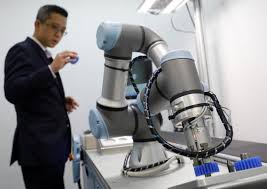
A Universal Robots employee demonstrates how a model of their industrial robot arms works in Singapore March 3, 2017.
Foreign precision engineering firms are investing more in Singapore, drawn by strong semiconductor demand and government incentives aimed at re-tooling an economy short of skilled labor.
The city-state is running programs worth billions of dollars to support productivity, automation and research, attracting global chipmakers including U.S.-based Micron Technology Inc and Germany’s Infineon Technologies.
This investment rush into electronics helped the technology sector log 57 percent output growth on average in October-February from a year ago, and kept Singapore from recession late last year.
“I’ve lived in Europe, I’ve lived in Japan, I’ve spent a lot of time in Taiwan and other countries. From a proactive standpoint, Singapore is about as good as it gets,” said Wayne Allan, vice president of global manufacturing at Micron, adding the Singapore government’s long-term vision was key to Micron expanding its investment.
Taking advantage of government grants, Micron is investing $4 billion to make more flash-memory chips in Singapore. It increased output by a third in the second half of last year and expects similar growth in the first half of this year.
Linear Technology Corp, a maker of analog integrated circuits, has opened a third chip testing facility in Singapore, and will produce 90 percent of its global test equipment in the city-state.
All this has created something of a virtuous circle in the semiconductor supply chain, with chip testing equipment supplier Applied Materials reporting record shipments to Singapore last year, said its regional chief, Russell Tham.
It’s unclear how much of this revival in Singapore’s $40 billion chip industry is due to a so-called ultra-super-cycle in the global memory chip sector, and Singapore remains a smaller player than South Korea and Taiwan.
“It is vulnerable to a pull-back,” said Nomura economist Brian Tan. “If there’s a turnaround in the semiconductor industry … it becomes a lot more apparent that the underlying growth momentum is not great.”
MOVING UP
However, there are real signs that the targeted government incentives are helping firms move up the value chain.
One of the larger programs is the Productivity and Innovation Credit, where Singapore has budgeted S$3.6 billion ($2.6 billion) for 2016-18. Another S$400 million automation support package is aimed at small firms, and a S$500 million Future of Manufacturing plan encourages testing new technologies.
The Ministry of Trade and Industry says it encourages manufacturers to “embrace disruptive technologies” such as robotics. “These measures will help ensure the manufacturing sector in Singapore remains globally competitive,” it said, attributing the strong semiconductors performance partly to demand from China’s smartphone market and improved global semiconductor demand.
For Feinmetall Singapore, whose products are used for testing semiconductor wafers, grants covered about two thirds of the $100,000 cost of a needle-bending machine it needed to help overcome an island-wide labor shortage.
“If we use the same methods as before … I don’t think we can expect any growth,” said Sam Chee Wah, the company’s general manager, noting Feinmetall Singapore struggled to retain some workers for much longer than a year, even after nine months of training.
GlobalFoundries Singapore, a wafer maker, has spent $50 million on 77 robots, each able to perform the tasks of 3-4 workers. This has helped the company move up the value chain into parts for self-driving cars and security-related chips for credit cards and mobile payments, says general manager KC Ang.
Singapore now has about 400 robots per 10,000 workers, the world’s second-highest density after South Korea. Most robots are used in electronics, according to the International Federation of Robots.
And further developments are in the pipeline.
AUTOS, IOT
At its Singapore manufacturing hub, Infineon is developing productivity tools such as robotics and automated guided vehicles which it hopes to deploy to other production sites. Dutch chipmaker NXP Semiconductors is also developing vehicle-to-everything technology, enabling vehicles to communicate with each other and roadside infrastructure.
Instead of trying to compete with high-volume producers such as China or Malaysia, Singapore has shifted to higher-end products, said Jagadish C.V., head of Systems on Silicon Manufacturing, another firm making semiconductor wafers.
“So you do the products which others can’t do so easily,” he said, adding his firm had shifted most of its output to specialized products, such as chips used in smartphones.
CK Tan, President of the Singapore Semiconductor Industry Association, noted the global chip industry is automating faster than other sectors because of cost pressure, a need to eliminate or reduce error, and have a consistent process control.
“In Singapore, it’s even more important for us to … look at how to speed up or increase the level of automation because of the lack of skilled resources,” he said. “The industry has recognized it has to move upscale. The government incentives play a part to allow the manufacturing side to be relevant, to be at least cost competitive.”
The Ministry of Trade and Industry said first-quarter growth in manufacturing – up 6.6 percent year-on-year, while overall GDP was up 2.5 percent – was due mainly to output expansion in electronics and precision engineering.
Integrated circuits were Singapore’s biggest export product among non-oil domestic exports in January-March, topping S$6 billion ($4.29 billion), according to trade agency IE Singapore.
($1 = 1.3972 Singapore dollars)
Source: http://in.reuters.com/article/us-singapore-semiconductors-analysis-idINKBN17T3DX
